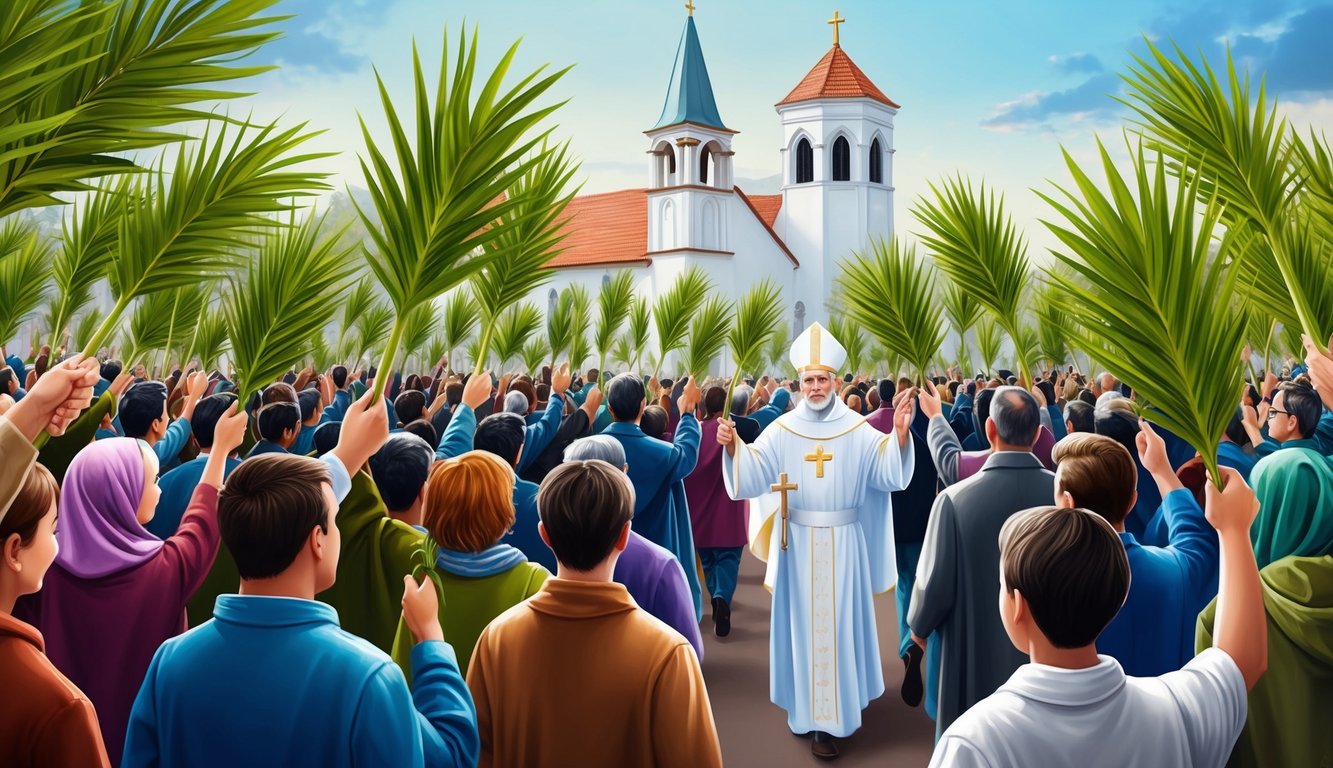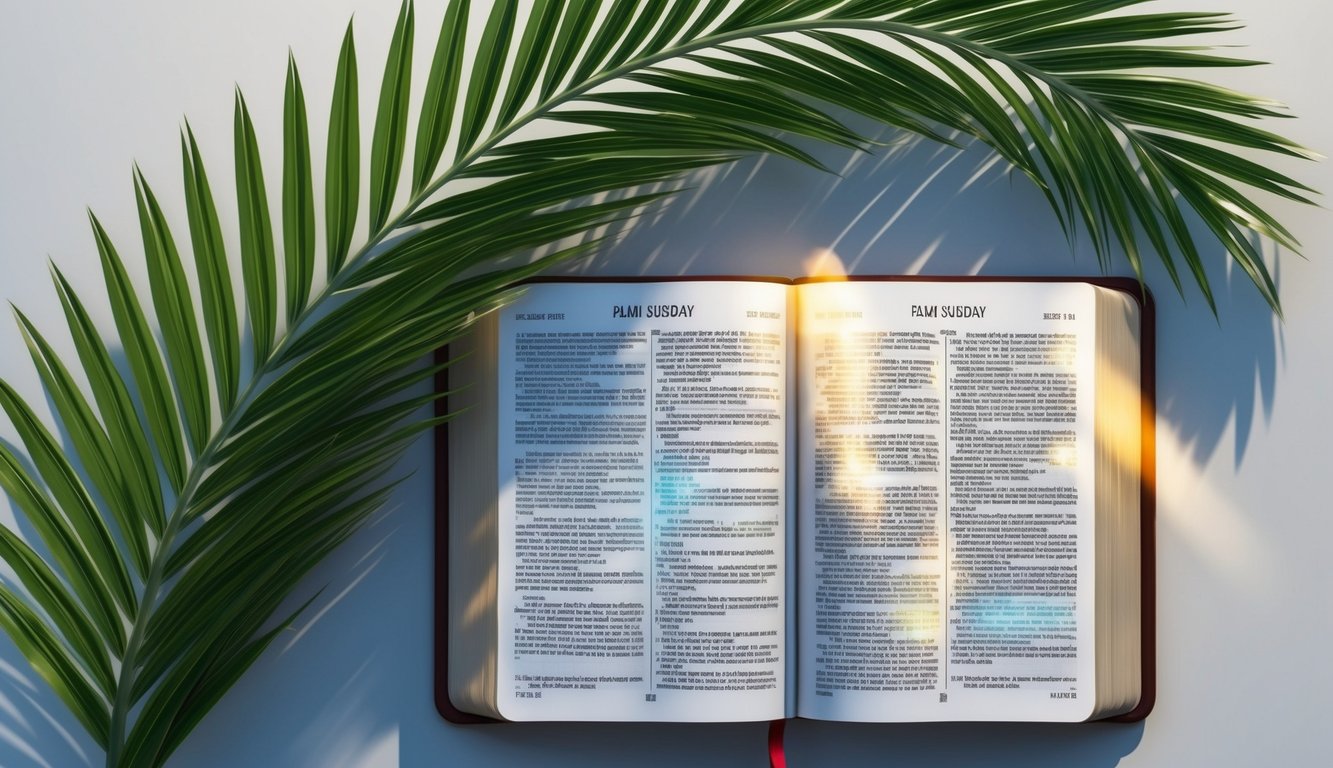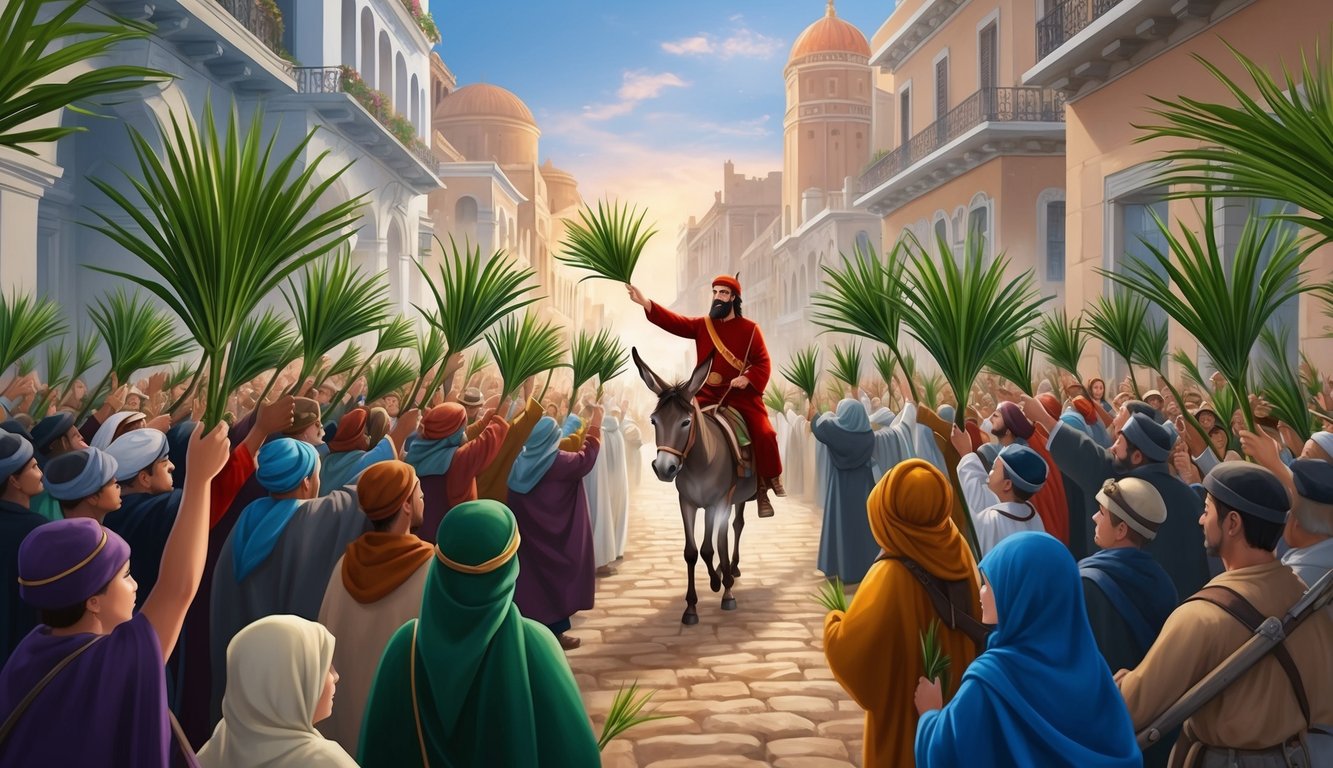Don’t Miss Out On This Unique Astrological Opportunity
Are you tired of spinning your wheels and getting nowhere? Simply put, you’re out of sync: you’re out of alignment with your astral configuration.
But: there’s a kind of map that can help you reclaim your alignment. Think of it as your own personal blueprint to success and happiness: a blueprint that will help you live your most amazing life.
Get started here.
Palm Sunday marks an important event in the Christian calendar as it commemorates Jesus’s triumphant entry into Jerusalem.
When you read the story, you will find that Jesus rode on a donkey while people waved palm branches and laid them on His path.
This significant act was a fulfillment of prophecy and signified the start of the events leading up to Easter.
Scripture describing this day is found in the Gospels, where you can explore the details of how people shouted “Hosanna” to welcome Jesus. These passages highlight the excitement and hope that surrounded Jesus’s arrival in Jerusalem, portraying Him as the awaited Messiah.
The disciples played a crucial role in preparing for this event, ensuring everything unfolded as Jesus had instructed.
Understanding the events of Palm Sunday deepens your connection to the Easter story.
By exploring these scriptures, you become part of the rich tradition that not only tells of Jesus’s journey but also invites you to reflect on His teachings and sacrifice.
This unique perspective can enrich your spiritual journey and provide meaningful insights as you prepare for the Easter celebration.
The Significance of Palm Sunday
Palm Sunday is a special day for Christians.
It marks the start of Holy Week, the week that leads to Easter.
On this day, you remember when Jesus entered Jerusalem.
This event is important in the Bible and is mentioned in all four Gospels.
Palm branches play a big role in Palm Sunday.
As Jesus entered the city, people spread palm branches on the road.
They did this to honor Him.
In those times, palm branches were a sign of victory and peace.
The crowd shouted “Hosanna” as Jesus rode a donkey. “Hosanna” is a term of praise.
It means “save us now.” By saying this, the people were recognizing Jesus as their King and Savior.
In church services, you may see palm branches used in different parts of the service.
They remind you of Jesus’ entry into Jerusalem and your faith in Him. Scriptures tell this story, often read aloud during Palm Sunday services.
For many, Palm Sunday is also a time to reflect on Jesus’ love and sacrifice.
It sets the tone for the rest of Holy Week, leading to Good Friday and Easter Sunday.
Biblical Narratives of Palm Sunday
Palm Sunday marks the triumphant entry of Jesus into Jerusalem.
Each Gospel provides unique details, bringing out various aspects of this important event.
You’ll notice differences in focus and description, as each Gospel writer highlights specific elements of Jesus’ entry, reflecting deeper theological themes.
The Gospel According to Matthew
In Matthew 21:1-11, you see Jesus approaching Jerusalem with his disciples.
This Gospel emphasizes the fulfillment of prophecy, specifically Zechariah 9:9, highlighting Jesus as a humble king riding on a donkey.
Matthew takes care to connect the event to Old Testament prophecies, showing a direct link between Jesus and the messianic expectations.
The crowd plays a significant role.
They spread their cloaks and branches on the road, shouting “Hosanna” to the Son of David, recognizing Jesus as the promised Messiah.
The city is stirred, questioning who this man could be.
Matthew underscores the theme of recognition and fulfillment, giving you a look at how prophecy and Jesus’ actions intertwine.
The Gospel According to Mark
Mark 11:1-11 provides a more concise narrative.
Here, Jesus instructs two disciples to find a colt.
This demonstrates his authority and omniscience, as they find everything as he described.
The event is marked by simplicity and authenticity, focusing on the actions of Jesus and his immediate followers.
Mark highlights the crowd’s enthusiasm, echoing the chants of “Hosanna.” The procession doesn’t end with immediate action in Jerusalem.
Instead, Mark notes that Jesus entered the temple and looked around, setting the stage for his later teachings.
This Gospel invites you to consider Jesus’ deliberate actions and the anticipation they create.
The Gospel According to Luke
In Luke 19:37, the narrative adds emotional depth and a different perspective.
Luke portrays a joyful crowd of disciples praising God for the miracles they had witnessed.
The focus is on Jesus as a prophet and miracle worker, and the mood among the people is one of celebration and awe.
Their praises echo the recognition of Jesus’ divine power and the hope He brings to the people.
Amidst the celebration, the message is clear—Jesus is the light, illuminating the path of salvation and demonstrating God’s kingdom through His works.
This moment highlights the deep connection between Jesus and His followers, as they rejoice in the fulfillment of God’s promises.
Unique to Luke’s account is the Pharisees’ request for Jesus to rebuke his disciples.
Jesus responds that if the disciples kept silent, the stones would cry out.
This vivid imagery suggests the inevitability of Jesus’ mission and message.
Luke’s narrative encourages you to think about the universal significance of Jesus’ actions during this event.
The Gospel According to John
John 12:12-19 brings a slightly different angle.
Here, the crowd gathers after hearing of Jesus raising Lazarus from the dead.
John’s Gospel emphasizes the role of witnessing, drawing connections between the miraculous signs and the public’s reaction.
This adds to the momentum of Jesus’ growing influence and reputation.
John notes the concern of the Pharisees, acknowledging the world’s attention on Jesus.
The use of palm branches is symbolic of victory and divine favor.
This narrative invites you to see the events of Palm Sunday as part of a larger story of belief, signs, and the unfolding plan of God’s kingdom.
Prophecies and Fulfillment

In the Bible, Zechariah 9:9 plays a significant role in prophecy.
It predicts the coming of a king, describing a future moment when the King of Israel would arrive.
This king would be humble, riding on a donkey, symbolizing peace and humility.
This prophecy is widely believed to be fulfilled by Jesus.
On Palm Sunday, you can read about Jesus entering Jerusalem on a donkey, which aligns with the description in Zechariah.
This act is celebrated as the fulfillment of the prophecy, highlighting Jesus as the expected King of Israel.
The link between prophecy and fulfillment isn’t just about predicting events; it also strengthens the faith of believers.
It shows how the events of the New Testament connect to Old Testament prophecies.
Understanding these links can deepen your appreciation of how scripture is woven together.
When you’re reading about Palm Sunday and this prophecy, it helps to think about the implications.
What does it mean for Jesus to be the humble King? Reflecting on this can enrich your experience of the story and offer new insights.
If you want to explore more about prophecy in scripture, resources like the Encyclopedia of Biblical Prophecy offer detailed insights.
They discuss various prophecies and their connections throughout the Bible, providing a deeper understanding of how these narratives unfold.
Cultural and Liturgical Observances

Palm Sunday is a celebration of Jesus entering Jerusalem.
This day is rich with cultural and liturgical practices that can be seen in various traditions and customs around the world.
Each location has its unique way of marking this significant day in the Christian calendar.
Traditions and Customs
On Palm Sunday, you will often see processions involving palm branches.
These are waved by the congregation to symbolize the welcoming of Jesus into Jerusalem.
In some churches, these palms are blessed and then carried by worshippers as part of the ceremony.
Songs and hymns also play a key role in Palm Sunday services.
These often recount the story of Jesus’s arrival, adding a joyful and spiritual atmosphere to the service.
In certain areas, people will fashion palm leaves into crosses, which are then kept as keepsakes for protection and blessing.
The use of palm branches, as mentioned in a study of liturgical worship, connects modern celebrations to ancient customs.
You may also notice churches decorating their spaces in green to reflect themes of renewal and life.
Palm Sunday Around the World
In different parts of the world, Palm Sunday is celebrated in diverse ways.
For example, in Latin Jerusalem, the celebration is a detailed reenactment of Jesus’s entry, involving large gatherings and community prayers.
This reenactment highlights cultural connections, deeply rooted in regional traditions as highlighted in research on the Palm Sunday celebration in Latin Jerusalem.
In the Philippines, this day is known as “Domingo de Ramos.” Parishioners bring handmade palm decorations to church for blessing.
Meanwhile, in Spain, Palm Sunday is marked by grand processions with ornately decorated olive and palm branches, reflecting the country’s rich historical influence on Christian festivals.
These global traditions showcase how the Palm Sunday Festival unites Christians in their faith while allowing for diverse expressions of worship throughout the world.
Reflections and Teachings

On Palm Sunday, you often reflect on Jesus’s entry into Jerusalem.
This event marks a significant moment where Jesus is hailed as a king.
The people placed palm branches before him, symbolizing peace and triumph.
This day is a pivotal part of the journey toward the Resurrection.
It reminds you of the coming salvation through Jesus, encouraging you to think deeply about its meaning in your life.
You might focus on the themes of peace as Jesus arrives humbly on a donkey.
This act teaches that true leadership is not about power or might but gentle service and love.
Reading scriptures such as Zechariah 9:9-10 can offer insights into the kind of king Jesus is.
He is portrayed as a ruler of justice and peace, providing a model for how you might live your life.
Reflections during Palm Sunday also lead you to appreciate the profound message of hope.
It encourages you to carry the spirit of understanding and love to your communities, embodying the teachings of Jesus.
Celebrating this day with these reflections can enrich your spiritual life, offering a deeper connection to the Christian story and its teachings on salvation.
By thinking about these themes, you may find new insights that inspire and guide your journey of faith.



